Last Updated on March 2, 2025 by Alexx
Trying to figure out how to explore the Balkans in two weeks without flying? It’s tricky but it’s possible, and this 2 week Balkans itinerary tells you all you need to know to plan your trip to this lesser-visited corner of Eastern Europe.
My love for the Balkans began with a few short city breaks to Sofia, Bucharest and Dubrovnik, but I’ve always wanted to travel this region in more depth.
Unfortunately due the tension between some of the countries, the messy transport infrastructure, and the casual attitude to things like timetables and routines, planning a Balkan itinerary is a biiiiit of a nightmare to say the least. So if you’re feeling stressed from reading 15 different itineraries without getting the answers you need to sort the logistics, I’ve been where you are and I feel your pain 🙃
So if you’re feeling stressed from reading 15 different itineraries without getting the answers you need to sort the logistics, I’ve been where you are and I feel your pain 🙃
For my first two week Balkan trip I actually ended up booking a group tour, my trip was creeping up on me and I didn’t have time to figure out the buses. The tour was fast-paced but fantastic (more info on it below), and it’s a great option if you want something easy with minimal planning needed, and it gave me a great intro to the region before I went back for a solo trip to Albania to explore deeper.
After both of those trips, I’ve spent hours researching transport links to show you how to get from A to B between every major stop in the region. I really hope this helps those of you who were as confused as I was when I was planning my trip!

Your perfect two week Balkans itinerary is really going to depend on your personal preferences, and because I am a chronic overthinker who feels bad for leaving anywhere out of an itinerary, in this blog post I’ve given you the rundown on all the major Balkan highlights and then have suggested a few different two week itineraries depending on what you’re looking for.
There are some optional add ons too, all with transport info listed, so you can essentially pick-and-mix the destinations that tickle your fancy.
Brevity isn’t my strong suit so this is a long one, but you can use the table of contents below if you want to skip to a certain destination or just go straight to the suggested itineraries at the end. Let’s dive in and sort this Balkan adventure out!

Quick summary: 2 weeks in the Balkans
There are a lot of Balkan destinations worth visiting and two weeks isn’t enough to see them all, so the ones you choose will really be determined by your interests and travel style.
If you’re looking for an easily replicable two week Balkan itinerary that is simple to follow, here’s my top suggestion:
- Sarajevo, Bosnia & Herzegovina (2 days)
- Mostar, Bosnia & Herzegovina (1 day)
- Dubrovnik, Croatia (2-3 days)
- Kotor, Montenegro (1-2 days)
- Shkoder or Tirana, Albania (1-3 days)
- Ohrid, North Macedonia (2 days)
- Skopje, North Macedonia (1 day)
- Sofia, Bulgaria (2-3 days)

But there are a few other key highlights that you could swap out or add on if you had more time, like:
- Zagreb, Croatia
- Split, Croatia
- The Albanian Riviera
- Kosovo
- Belgrade, Serbia
- Bucharest, Romania
- Transylvania, Romania
- Greece
I also have a bunch of alternative Balkan itinerary suggestions at the end of this blog for people with a particular interest in history, food or sun and sea, you can skip to those here.
Phew! Read on to hear more about each of these destinations and figure out which ones are your must-dos.

Map of the Balkans highlights
I’ve used blue pins for the eight destinations in my recommended two week Balkan travel itinerary to show you how they all line up, and then the red pins are the other highlights that you can detour to or add on (but as you can see, they all lie a bit further out from the easy blue route).

Planning two weeks in the Balkans
Where are the Balkans?
The term ‘the Balkans’ refers to the countries in the Balkan peninsula, a region in Southeastern Europe.
What countries are in the Balkans?
There’s ongoing debate on the exact borders of the Balkan peninsula and what countries are counted, but the core Balkan countries are:
- Albania
- Bosnia & Herzegovina
- Bulgaria
- Croatia
- Kosovo
- Montenegro
- North Macedonia
- Serbia
Romania and Slovenia are sometimes included, it really depends on who you speak to.
Greece is geographically recognised as a Balkan country but it has a tourism scene big enough that travellers generally plan a Greece itinerary on its own rather than as a part of a regional trip, and for this reason I’ve left it out of this itinerary (but have suggested an easy way to add it on at the end).
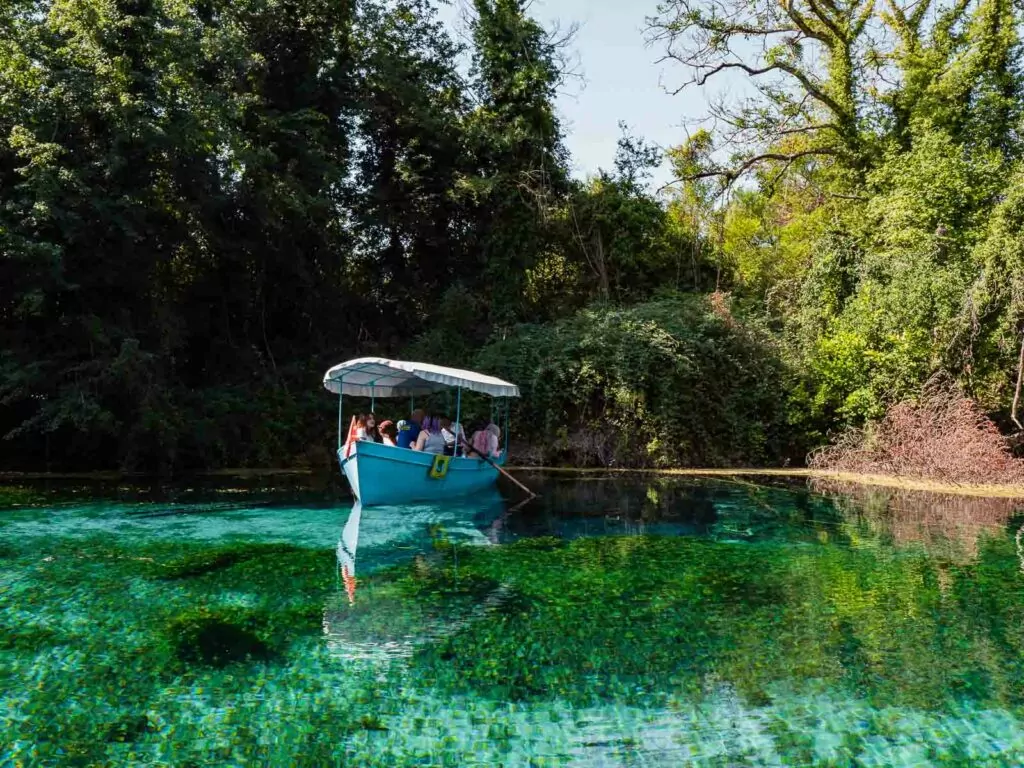
What is the best Balkan country to visit?
There’s no single ‘best’, it really depends on what you’re into!
From the ones on this itinerary, the best Balkan country for me was Bosnia & Herzegovina, the history, cultural diversity and natural scenery exceeded all my expectations.
If you’re looking for sun and sea then Croatia, Albania and Montenegro will probably be the best ones for you.
For foodies you’ll need to visit Sofia in Bulgaria and Tirana in Albania.
History buffs can’t miss Sarajevo in Bosnia & Herzegovina and Belgrade in Serbia.
And if you’re there for the views, Kotor in Montenegro, Mostar in Bosnia & Herzegovina, and Lake Ohrid in North Macedonia are unbeatable.

When is the best time to visit the Balkans?
Different parts of the Balkans have wildly different experiences in different seasons.
☀️ Summer (June to August)
Croatia and coastal Montenegro are extremely busy, with cruise ships and tour buses bringing in thousands of visitors each day. Hot and sunny, but the crowds can be overwhelming.
Easy day trips from these destinations like Mostar in Bosnia & Herzegovina are also busy, but the crowds dissipate after 4pm when day trippers head back to Dubrovnik or their cruise ship.
The Albanian Riviera is growing in popularity during summer with people trying to escape the Greece and Croatia crowds, the hot spots of Ksamil and Sarandë will be very busy and honestly not enjoyable. Smaller towns like Himarë will give you a more chilled out experience.
The other highlights will likely be pretty hot but even in peak summer they never get anywhere near as busy as the main European destinations. Destinations like Ohrid, Sofia, Sarajevo and Belgrade are probably some of the best options for a summer trip in Europe if you want to escape the crowds!
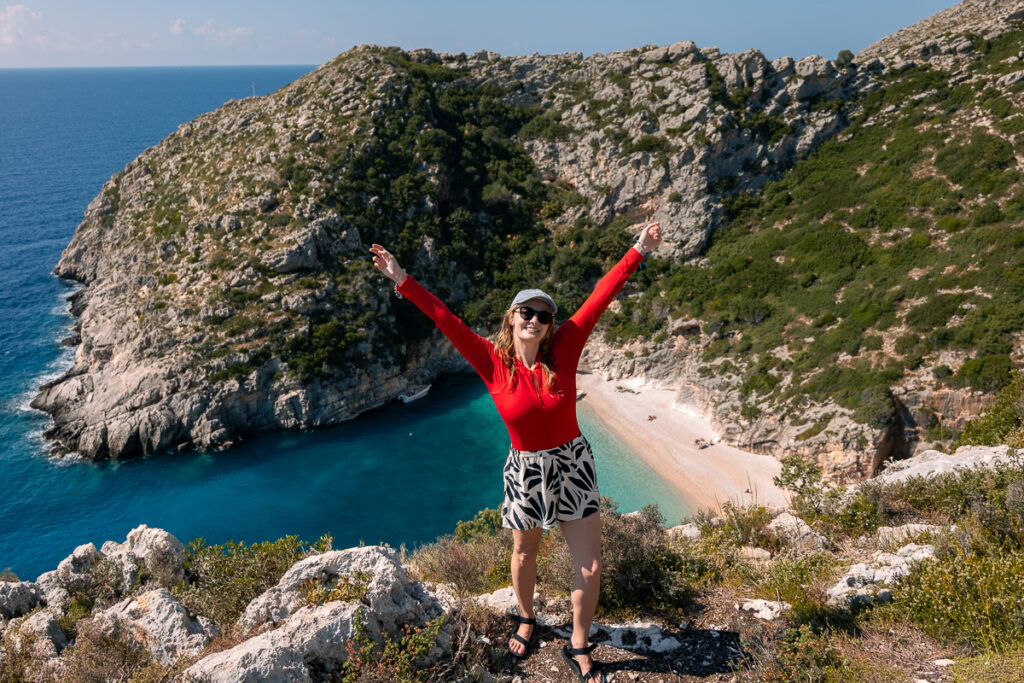
🍂 Shoulder season (September to November + March to May)
My favourite time to explore most European destinations, in the shoulder season the number of visitors dies down, prices drop and the Balkans will still have pleasant weather.
❄️ Winter (December to February)
Winter in the Balkans will depend entirely on where you go, some of the region will be covered in snow and some might still enjoy sunshine and not-too-cold temperatures.
The Balkans offers some of the cheapest skiing in Europe, you’ll find some Christmas markets in most major cities, and you’ll be able to enjoy the main landmarks and tourist experiences with hardly any other tourists around.

How to get to the Balkans
✈️ By plane: If this Balkans trip is a standalone trip for you (as in not part of a wider Europe itinerary) then it’s best to arrive by plane. You can find cheap flights on budget airlines to cities like Sarajevo, Belgrade, Sofia, Tirana and Zagreb.
🚂 By train: If you’re already travelling around Europe and trying to minimise your flights, you can reach the Balkans by train in a few different ways:
- You can reach Zagreb in northern Croatia by train from Ljubljana (Slovenia), a sleeper train from Stuttgart (Germany) or a sleeper train from Zurich (Switzerland)
- You can reach Sofia in Bulgaria by sleeper train from Istanbul (Turkey)
- You can reach Bucharest in Romania by sleeper train from Budapest (Hungary) or Vienna (Austria)
🚌 By bus: I’ll always go for a sleeper train over a long bus, but if the train routes above don’t work for you then you’ll be able to find a bus to connect you from any major European hub to any Balkan city with 1 or 2 changes (and a day or two of driving!).
⛴️ By ferry: There are ferry connections between Italy and Croatia, Italy and Albania, and Greece and Albania.

How to get around the Balkans
🚌 Bus: The most common and affordable way to travel between the Balkans is by bus. Flixbus is king here, but I’d recommend searching your route on Omio to see all options side-by-side and find the time/price/route that works for you.
🚗 Car: Renting a car in the Balkans means you’re not at the mercy of infrastructure inefficiencies, but it’s not for the faint-hearted. Some important things to be aware of before renting a car:
- The road conditions are extremely poor in some places, particularly off the main highways
- You might come face to face with livestock roaming rural roads
- Most people don’t obey speed limits (and as a tourist you have to, or your insurance will be void if you crash)
- Manyyyyy drivers pass cars on blind corners or when there are cars literally coming towards them
- Border crossings take longer in a private car than on a bus or organised tour
- Some car companies will allow you to visit other Balkan countries, some might not
- Corrupt police do exist, particularly in Albania and Serbia (this is what the locals told me). They might pull you over and offer you the choice of paying a fine to them in cash or going to the police station and paying ten times that amount. I can’t give you any actual advice here, and this stuff can be really tricky to navigate if you haven’t dealt with it before!
- Albania has a high ratio of wild drivers, someone pulled out right in front of us and scraped the whole side of our bus, they were lucky our driver reacted fast enough to avoid a head on collision! Private car ownership was actually banned in Albania until the fall of communism in the early 90s, so the country’s driver licensing, policing of road rules and general understanding of safe driving is about 40 years behind the rest of the world.
If you’re a confident driver and can handle these risks then driving does give you much more flexibility to travel at your own pace and go wherever you want, but I just want to share the reality with you so you know what to expect.

✈️ Plane: You *could* fly from one city to another, the flights are short and often cheap, but when you consider the time and stress of getting to the airport, going through security, waiting for bags and then getting to your next hotel honestly it won’t save you a huge amount of time vs. the bus trips.
🎤 Group tour: If you’re trying to figure out your Balkans itinerary and can’t wrap your head around the logistics, or if you’d prefer to see this beautiful part of Europe with minimal stress, there are some group tours that follow a very similar route to what I’ve mentioned below.
I personally did the Travel Talk Amazing Balkans and Transylvania tour, it’s 16 days all up but you can also just book the Balkans portion without the Transylvania add on. Travel Talk offers coach trips for all ages but in my experience (I’ve done three trips with them) they’re generally skewed to mid-20s to mid-30s, with quite a lot of Kiwis and Aussies. In saying that though, our Balkans trip had people from all over the world and included a few couples in their 60s and 70s, who were absolute legends!
Travel Talk’s Balkans tours are highly-rated, they’re definitely fast-paced but you get to see so many highlights without having to worry about border crossings, bus timetables and navigating each city independently.

Our Transylvania and Balkans tour itinerary was this:
- Day 1: Bucharest (Romania)
- Day 2: Bucharest
- Day 3: Sinaia, Bran, Brasov
- Day 4: Sighisoara, Cluj-Napoca
- Day 5: Salina Turda, Hunedeoara, Sibiu
- Day 6: Bucharest
- Day 7: Veliko Tarnavo, Plovdiv (Bulgaria)
- Day 8: Sofia (Bulgaria)
- Day 9: Belgrade (Serbia)
- Day 10: Sarajevo (Bosnia & Herzegovina)
- Day 11: Mostar, Trebinje (Bosnia & Herzegovina)
- Day 12: Dubrovnik day trip, stay in Trebinje
- Day 13: Kotor (Montenegro), stay in Shkoder (Albania)
- Day 14: Tirana (Albania), Ohrid (North Macedonia)
- Day 15: Skopje (North Macedonia)
- Day 16: Sofia (Bulgaria)
There is also an option to veer off from Skopje and continue the trip into Greece, with a few days visiting Thessaloniki, Delphi and Athens.

How much to budget for this Balkans travel itinerary
I’m using the Euro (€) as the example currency because it’s easier to compare that way, but keep in mind that most Balkan countries have their own local currency.
Overall the Balkan region is very kind to your wallet, and many Balkan cities are known as being some of the best budget cities in Europe. Here’s a guide to how much you should expect to spend in different destinations.
Albania (aside from the Riviera), Bosnia & Herzegovina, North Macedonia and Serbia are all cheap and cheerful even in the main cities. For accommodation you can expect to pay €8-12 for a hostel dorm with breakfast included, €20-40 for a simple guesthouse, and there are decent hotels from €25-40 a night. You could quite easily live off €8 a day with hostel breakfasts and bakery/supermarket food, and I’ve had some incredible, hearty meals in these countries for just €6-8 with a local beer for €1-2.

Bulgaria and Romania offer similar prices outside of the main centres, but their capital cities (Sofia, Bucharest) and popular destinations (Plovdiv, Brasov, Sibiu) are slightly more expensive. Still brilliant value, just a bit pricier.
Montenegro is the next step up, outside of Kotor you’d be looking at similar pricing to Sofia and Bucharest, but Kotor is much, much more expensive. Expect to pay €20-30 for a bed in a hostel dorm (even higher in summer), €35+ for a private room and €50+ for a hotel. There are some affordable casual dining options for pizzas, BBQ plates and gyros, but most Old Town restaurants charge €15-25 for a main meal. Prices have risen drastically since my first visit back in 2019, so if you’re looking for a guide to what you’ll spend in Kotor, anything pre-2023/2024 is likely outdated.
And finally we have Croatia! The less touristy parts of Croatia are still pretty budget-friendly but the major coastal hubs like Dubrovnik are harsher on your bank account. Hostel dorms start from €20 a night in the low season but as high as €40-50 a night on a weekend in summer 🫠 the cheapest private rooms in the low season range from about €40 a night and in the high season you’ll be paying €80+ for a basic private room. Dubrovnik Old Town meals will set you back €12-15 for something casual or light, or from €15-30 for a heartier meal.

The ultimate 2 week Balkans itinerary
Who is this Balkans itinerary for?
Like all of my Europe itineraries, I’ve written this from the point of view of a traveller wanting to maximise their time off work and who is happy to travel as a faster pace to see, do and eat everything they want! As someone from the other end of the world I totally understand wanting to make the most of your few weeks in Europe if you’ve spent thousands of dollars and flown 24+ hours to get here.
This itinerary does include a couple of long bus journeys, some overnight options too, but if you prefer to travel at a slower pace then you can absolutely just pick 3-4 of the highlights below and DIY your own Balkans trip itinerary based on your travel style. Each to their own, do what works for you 😊

How to use this Balkans itinerary to plan your own trip
You can use this Balkans travel itinerary in two ways.
I’ve listed a pretty basic run down of the key highlights in the Balkans below, to give you a quick overview of why each one is worth visiting, what to do there and some top-rated places to stay. Read through and take notes of the cities/spots that pique your interest! From there you should have a hit list of the key destinations to build your Balkan trip itinerary, and you can refer to the ‘how to get to’ section in each highlight to plot your bus journeys.
Or if you’re keen to start with a rough plan without having to make too many decisions, I’ve listed some suggested two week Balkan itinerary routes after the highlights. Check those out to find a route that suits you, then scroll back up to look at my suggestions for those destinations. You can skip straight to the suggested itineraries by clicking here.
Important: Also just a quick note but where I say ‘how long to stay’, this is the minimum amount of time to make the trip worth it. You can absolutely stay longer and every destination on here deserves longer than what I’ve recommended, but with just two weeks in the Balkans you’ve got to make some compromises. Feel free to cut my suggested itineraries in half and spend twice as long in the destinations if that suits you better!

Sarajevo, Bosnia & Herzegovina
How to get to Sarajevo: I’ve listed Sarajevo as the start of the trip because the only bus connections to other highlights on this list are very long drives. You can find super cheap flights into Sarajevo Airport on budget airlines like Wizz Air and Ryanair, or if you’re travelling overland your best options are direct bus from Zagreb in Croatia (7-8h), Ljubljana in Slovenia (10-12h) or Belgrade in Serbia (8h 45m-9h 15m).
How long to stay: 2 days

About Sarajevo
Sarajevo is a real enigma. It’s a must-visit city to gain an understanding about the Balkan region’s culture clashes and the destruction they caused, but its current environment of cultural diversity, youthful energy and insane value for money balances the poignant with the positive.
A couple of days here will give you time to learn about Sarajevo’s significance in WWI, the brutal Bosnian War of 1992-1995, the rebuild after those atrocities, and how these days the diverse cultures, cuisines and architecture stand side by side to make up a wonderfully unique capital city.
The energy here is unmatched, there’s an undeniable creative vibe throughout museums, galleries and markets, and it’s one of the cheapest city breaks in Europe.

Things to do in Sarajevo
- Join a free 2h walking tour, you need to hear firsthand about the Siege of Sarajevo from a local guide for a deeper understanding, or get a slightly more in-depth experience with this top-rated 3 hour tour (still very cheap!)
- Visit Galerija 11/07/95, a powerful and confronting art gallery dedicated to the Srebrenica Genocide
- Shop for souvenirs in Baščaršija, the historical bazaar
- Take the Sarajevo cable car to Trebević for the best views
- Enjoy some of the cheapest food you’ll find in Europe, I highly recommend Ćevabdžinica Željo for the traditional Balkan dish ćevapi (grilled minced meat)
- Watch the sunset from the Yellow Fortress
- Spot some of the Sarajevo Roses, where mortar-damaged roads from the siege were filled with red resin and now serve as a memorial for war victims
- Indulge in local wine at the weird and wonderful Zlatna Ribica, an antique-themed wine bar and cafe
- Visit the Museum of Crimes Against Humanity and Genocide for a very moving but fascinating personal account of the war from actual victims


Where to stay in Sarajevo
Budget:
- Hostel Franz Ferdinand (9/10 from 1760+ reviews)
- Hostel Kucha (9.4/10 from 650+ reviews)
- The Good Place Hostel (9.6/10 from 300+ reviews)
- Villa Basamak (9.4/10 from 360+ reviews)
Mid-range:
- Old Town Hotel (9.4/10 from 1490+ reviews)
- Hotel Sana (9.2/10 from 1750+ reviews)
- Pansion Fawlty Towers (9.8/10 from 90+ reviews)
- Apart Hotel Family (9.6/10 from 800+ reviews)
Luxury:
- Malak Regency Hotel (9/10 from 2880+ reviews)
- Hotel Hills Resort (8.5/10 from 4750+ reviews)

Mostar, Bosnia & Herzegovina
How to get from Sarajevo to Mostar: 2.5h direct bus
How long to stay: 1 day
About Mostar
Mostar is Bosnian scene you’ve probably seen all over Instagram, with its iconic Stari Most bridge standing high above the turquoise Neretva River.
What you might not know is that the bridge is actually a reconstruction! It was originally built during the 16th century Ottoman era but was destroyed in 1993 during the war, before being rebuilt in the early 2000s and reopening in 2004.
Mostar is beautiful but it’s the most popular tourist attraction in the country so it does get busy, especially from 10am-4pm when the day trippers arrive from Dubrovnik. Spend a night here and make the most of the afternoon/evening and early morning before your next stop.


Things to do in Mostar
- Join a free waking tour to get your bearings
- Watch the local divers jump off the side, it’s a 24m drop into the freezing cold river
- If you’re a daredevil yourself, you can make the jump too with some training from a local. Head to the Diving Club at one end of the bridge, you’ll need to do some shorter practice jumps and pay a €25 fee before taking the leap of faith. (It is dangerous, people have died, do it at your own risk!)
- Enjoy a riverside lunch with a view of the bridge at top-rated Restaurant Bella Vista
- Climb the minaret of the Koski-Mehmed Pasha Mosque for an amazing view (but the steps and platform at the top are very narrow)
- Visit the Museum of War and Genocide Victims
- Take a boat trip down Neretva River or join a kayak safari
- Sip traditional Bosnian coffee at Café de Alma or Fabrika
- If you can spare an extra day, take a day trip to Blagaj to see the famous house carved into the hill, and then to Kravice Waterfalls for a refreshing swim and lush scenery


Where to stay in Mostar
Budget:
- Hostel Mirror (9.3/10 from 530+ reviews)
- Rooms Vedran (8.9/10 from 90+ reviews)
- Hostel Taso’s House (9.1/10 from 90+ reviews)
Mid-range:
- Patria Villa (9/10 from 1230+ reviews)
- Hotel Amicus (9.2/10 from 890+ reviews)
- Hotel Almira (9.2/10 from 1060+ reviews)
Luxury:
- Hotel Mepas (9.2/10 from 2000+ reviews)
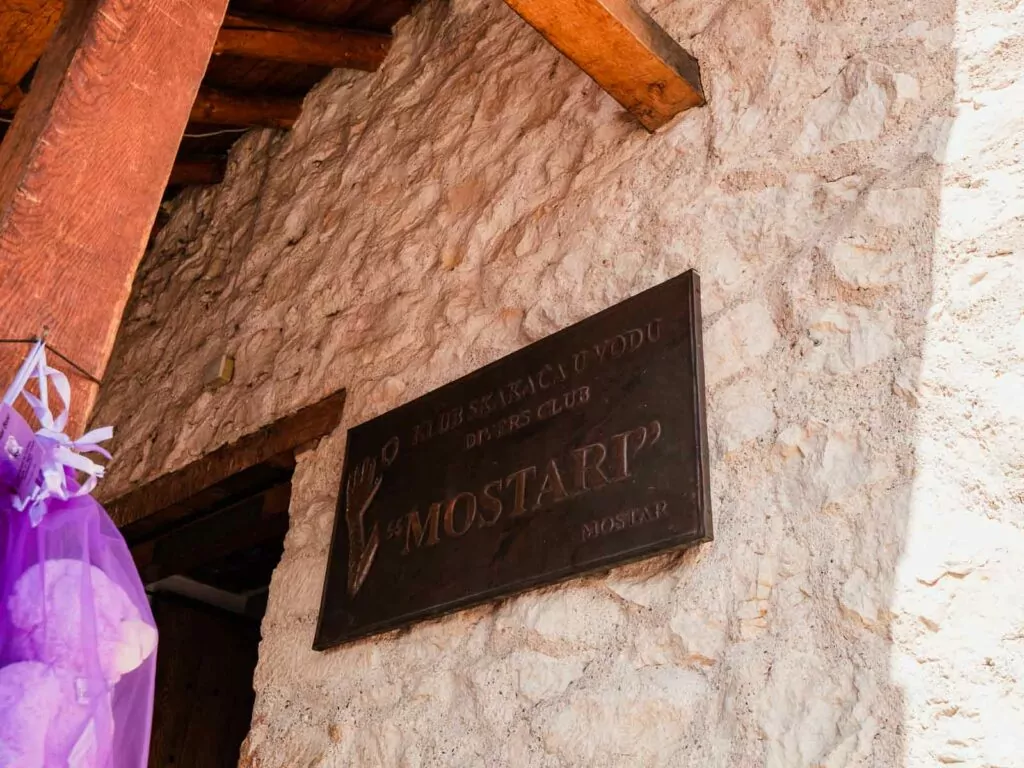
Dubrovnik, Croatia
How to get from Mostar to Dubrovnik: Direct bus, 3h 15m
How long to stay: 2-3 days
About Dubrovnik
The ‘Pearl of the Adriatic’ lets you take a giant step back in time, with polished limestone streets to wander and fortified walls to explore.
The city’s Game of Thrones fame has certainly removed any chance of it being quiet ever again, but it’s still absolutely worth a visit for the history, the architecture, the filming locations and the coastal views. Just be prepared for crowds year-round, and a higher price tag than anywhere else on this list.


Things to do in Dubrovnik
- Walk the ancient city walls, best to do this first thing in the morning before the heat sets in and the cruise ship excursion groups arrive
- Do the Free Spirit free walking tour, they have a 5/5 rating on Google from more than 2000 reviews!
- Join a Game of Thrones film locations tour, or hunt down the famous spots yourself
- Indulge in ocean-to-table seafood, my number one pick for lunch or dinner is Trattoria Carmen
- Take the cable car to Mount Srđ for an incredible view of the walled city
- Escape to Lokrum Island for beautiful gardens and loads of rabbits (very cute but detrimental to said gardens)
- Explore the coast with a kayak tour
- Cruise around the stunning Elaphiti Islands
- If you have more time, consider jumping on one of the luxury yacht charters from Sail Croatia


Where to stay in Dubrovnik
Budget:
- Hostel Free Bird (8.5/10 from 620+ reviews)
- Old Town Hostel (8/10 from 560+ reviews, average reviews but best located hostel in Dubrovnik)
- Hostel 365 For U (8.6/10 from 860+ reviews)
Mid-range:
- City Hotel (9.2/10 from 1500+ reviews)
- Boutique Hotel Porto (9.1/10 from 1780+ reviews)
- Royal Neptun Hotel (9/10 from 3700+ reviews)
- 7oaks Noble House (9.7/10 from 70+ reviews, more expensive than the others but mid-range for Old Town)
Luxury:
- Boutique Hotel Kazbek (9.4/10 from 260+ reviews)
- Hotel Bellevue (9.4/10 from 760+ reviews)
- Rixos Premium Dubrovnik (9.2/10 from 5400+ reviews)
- Villa Dubrovnik (9.5/10 from 130+ reviews, the epitome of Mediterranean luxury)

Kotor, Montenegro
How to get from Dubrovnik to Kotor: Direct bus, 2h 10m
How long to stay: 1-2 days
About Kotor
Wedged between steep mountains and a shimmering bay, Kotor is Montenegro’s crown jewel.
Its UNESCO-listed Old Town is a maze of cobblestone alleys and charming hole-in-the-wall shops and restaurants, there are ancient walls worth a hike for epic views, and (the best part of Kotor in my opinion!) there are thousands of cats that are loved and looked after by locals and tourists alike.
Inflation and its proximity to Dubrovnik has certainly pushed prices up in recent years, but for travellers searching for epic views, it’s a must-see. Affordable accommodation is particularly limited, book in advance to nab a cheap bed at one of the few hostels in town.


Things to do in Kotor
- Meet the cats! You’ll find them in the backstreets, sleeping on restaurant chairs or even all the way up the top of the city walls
- Walk the city walls, it’s 1350 steps to the top but if you’re short on time you could just go up to the church for magical views (about 30 mins)
- Take a boat trip to the vibrant Blue Cave or to Perast Old Town and Our Lady of the Rocks, a church on an island in the middle of the bay
- Visit St. Tryphon’s Cathedral to see 14th century frescoes
- Head to the nearby resort town Budva (30 min bus) for lively nightlife and thrills like paragliding
- Go whitewater rafting on the Tara River
- My top pick for food is La Catedral Pasta Bar


Where to stay in Kotor
Budget:
- Centrum Hostel (9.3/10 from 750+ reviews)
- Montenegro Hostel 4U (9.2/10 from 780+ reviews)
- Hostel Pupa (9.2/10 from 1740+ reviews)
Mid-range:
- Art Hotel Galathea (8.9/10 from 330+ reviews)
- Hotel TIANIS (8.8/10 from 700+ reviews)
- Hotel Libertas (9.5/10 from 670+ reviews)
Luxury:
- Hyatt Regency Kotor Bay (9.1/10 from 1940+ reviews)
- Boutique Hotel Astoria (9.1/10 from 650+ reviews)
- La Fleur Boutique Hotel (in Tivat, 6km from Kotor, 9.6/10 from 290+ reviews)

Tirana or Shkoder, Albania
How to get from Kotor to Tirana: Direct bus, 6h
How long to stay: 1 day for the city, an extra day if you want to do a day trip to Berat or Kruje
About Tirana
Often overlooked for more charming Balkan cities, Tirana does offer one main thing that makes it a necessary addition to a Balkan travel itinerary: a BRILLIANT culinary scene. Foodies, I promise it’s worth a visit.
If you’re not fussed on food and don’t have a particular interest in Albanian history and culture, then I have to be totally and say that Tirana probably isn’t worth it. Best to skip it and substitute it for Shkoder/Komani Lake if you’re looking for landscapes, or head down to the Albanian Riviera for beach time.
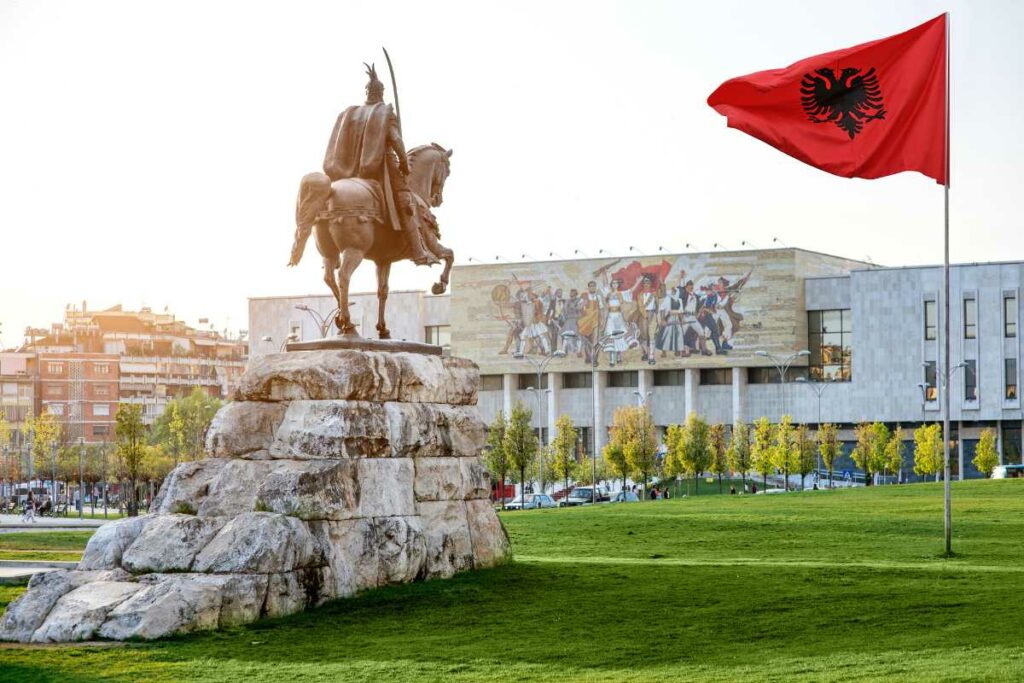
Things to do in Tirana
- My absolute top food recommendation is Tartuf, a truffle restaurant that offers maybe the best value truffle dishes in the world. I had a three-course truffle-heavy lunch for €14 which is UNHEARDOF, the truffle mashed potato was the best mashed potato I’ve ever had in my life, this is the kind of restaurant experience I’ll remember forever.
- Other eateries to add to your list are Happy Belly / Eat Smart for vegetarian, Delano Lounge for a fancy meal, Fresco Fish for seafood and Artigiano at Vila for pasta
- Learn about Albania’s rough history at BUNK’ART, a Cold War bunker that’s been repurposed into a museum and art gallery
- Escape the city with a day trip to Bovilla Lake for hiking, Berat for a gorgeous UNESCO-listed hillside town, or Kruja Castle
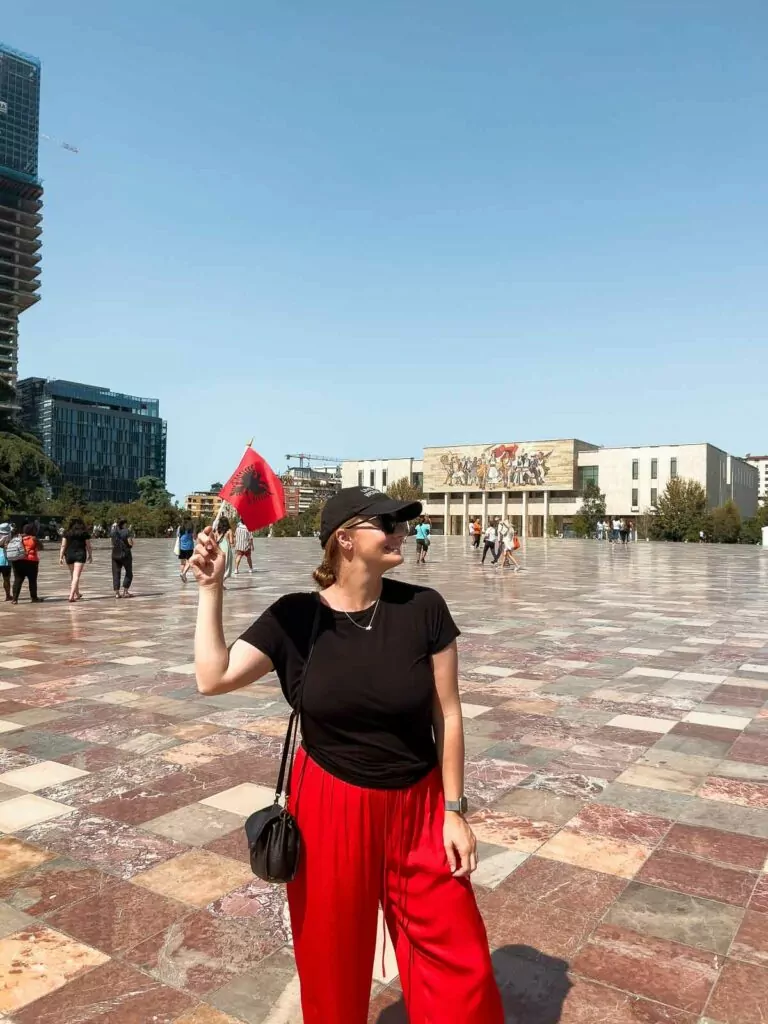

Where to stay in Tirana
Budget:
- ART Hostel (9/10 from 460+ reviews)
- Blue Door Hostel (8.9/10 from 500+ reviews)
- Vanilla Sky Boutique Hostel (9.1/10 from 1150+ reviews)
Mid-range:
- Hotel LONDON (9.2/10 from 1300+ reviews)
- Ramel Hotel (9.5/10 from 400+ reviews)
- Hotel Restaurant Gloria (9.4/10 from 1100+ reviews)
Luxury:
- Capital Suites Center (9.1/10 from 160+ reviews)
- Xheko Imperial Luxury Hotel (9/10 from 1470+ reviews)
- Lot Boutique Hotel (8.9/10 from 3400+ reviews)
- Arté Boutique Hotel (8.8/10 from 330+ reviews)
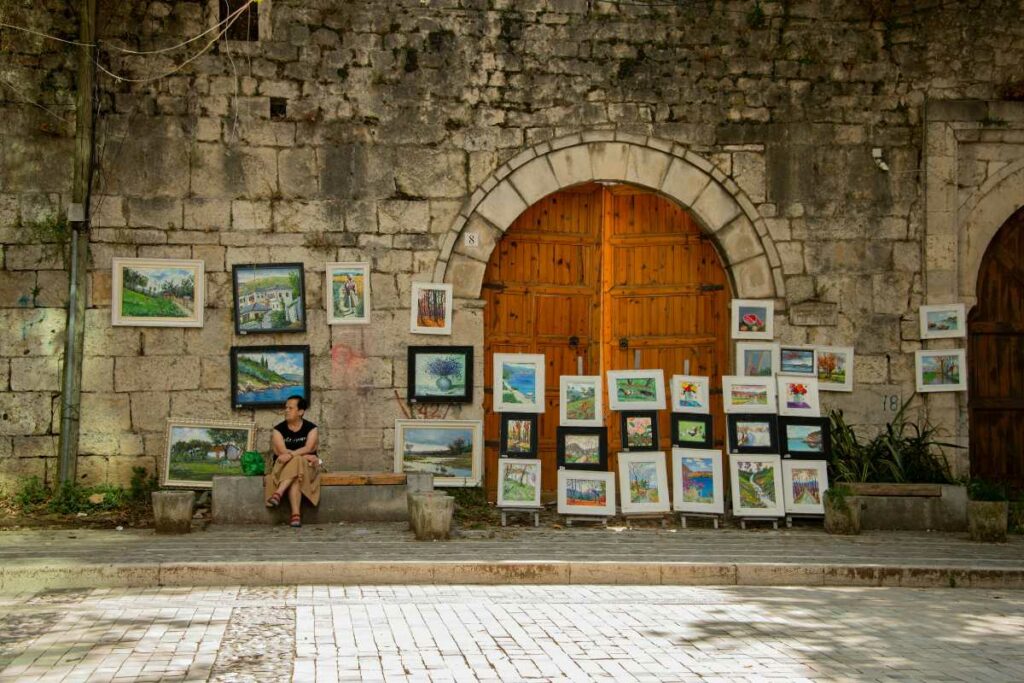
Shkoder, Albania
How to get from Kotor to Shkoder: Direct bus, 4h 10m
How to get from Tirana to Shkoder: Direct bus, 2h
How long to stay: 1 day for the city, 2-3 days if you want to do Komani Lake or hiking in the Alps
About Shkoder
With little old ladies riding bikes around the old town in long skirts and an umbrella in their hand, Shkoder is one of the cutest cities I’ve ever visited. It’s slow-paced, old-fashioned and offers fantastic value for money.

The food here is unexpectedly excellent, I had some of the best Italian food I’ve ever had outside of Italy, and you get even better bang for your buck than in Tirana.
For the mountain goats amongst you, or if you’re like me and just looove epic places to stay, Shkoder is the gateaway to the stunning Komani Lake and the hiking trails of the Albanian Alps. They require a bit of a journey to get there so you’d need to set aside 2-3 days but if you can fit it in, I promise they’re worth it.
Things to do in Shkoder
- Do as the locals do and rent a bike to explore the old town and beyond
- Wander around the ancient walls of Rozafa Castle
- Do a food tour to get a taste for northern Albanian cuisine
- Visit the Marubi National Museum of Photography
- Bike out to Lake Skadar or Mesi Bridge
- Book a side trip to Komani Lake (doable by day trip but I’d recommend staying at least one night at the magical Riverside Komani Lake)
- Or tick off arguably the best hike in Albania, the Theth to Valbone Pass

Where to stay in Shkoder
Budget:
- Corner Hostel (my top hostel pick, clean and comfortable dorms with privacy curtains, right opposite the main bus stop, 9/10 from 70+ reviews)
- Bed Station (8.7/10 from 250+ reviews)
- Guest House Zadeja (9.2/10 from 320+ reviews)
- The Wanderers Hostel (9.1/10 from 780+ reviews)


Mid-range:
- Amo’s Hotel (9.5/10 from 310+ reviews)
- Lille France Apartments (9.6/10 from 390+ reviews)
- Hotel Ikona (9.1/10 from 340+ reviews)
- Hotel Mozart (9.4/10 from 170+ reviews)
Luxury:
- Hotel Colosseo & Spa (8.5/10 from 730+ reviews)
- Villa Teverde (9.6/10 from 180+ reviews)
- TRIBUTE Hotel (9.4/10 from 120+ reviews)
Albanian Riviera (optional)
How to get from Tirana to the Albanian Riviera : Direct bus to Sarande (4.5) via Vlore, Dhermi and Himare
How long to stay: Totally up to you!

About the Albanian Riviera
The Albanian Riviera is a bit of a detour from the rest of this itinerary and you’ll need to get back to Tirana to make your way through to Ohrid, so I’ve listed it as optional.
If you want to connect your Balkan travel itinerary with Greece then this is a great way to link the two, there’s an easy ferry from Sarandë to Corfu and the Ionian Islands. And if you’re wanting to spend more time exploring Albania, I’ve got a full two week itinerary for Albania without a car.
Albania’s Riviera was once one of the cheapest Mediterranean getaways, though the viral ‘This is the MALDIVES of EUROPE’ Reels and TikToks have definitely contributed to growing international tourism and skyrocketing prices. These days the hotels, restaurants and tours in Sarande and Ksamil (the two main hubs in the Riviera) are on par with Greece and Croatia, but you can find better deals in smaller places like Himarë.
July/August will be packed, like anywhere else on the Med coast, but June and September offer a more unspoiled Albanian Riviera experience.
👉🏼 READ MORE: All you need to know about the Albanian Riviera

Places to visit in the Albanian Riviera
- Vlorë: The northern part of the riviera, it’s a lively resort town with sandy beaches, historical significance and easy access to and from Tirana, but not as charming as the southern riviera towns
- Himarë: Slightly north of Sarandë and accessible by bus from Tirana, more of a local vibe with fewer tourists, my top pick out of these options!
- Sarandë: A popular base for southern riviera adventures and a buzzing nightlife scene, but it feels the pressure of overtourism
- Ksamil: 30 min bus from Sarandë, idyllic beaches with bright blue water, but all are private and you need to pay for a sunbed (usually 20-50EUR for a pair) to be able to swim
- Dhermi: Pristine beaches, a beautiful old town and less people than Sarandë and Ksamil, but it’s more of a boutique vibe so higher end options for hotels and restaurants
- The Blue Eye: A crystal clear freshwater spring flanked by mountains, you can book an excursion from Sarandë
- All the beaches! The best ones are only accessible by boat so you’ll want to book a day trip, I went with Lido Boat Tours from Himare to a bunch of stunning bays and coves, it was the highlight of my time in Albania’s Riviera for sure.
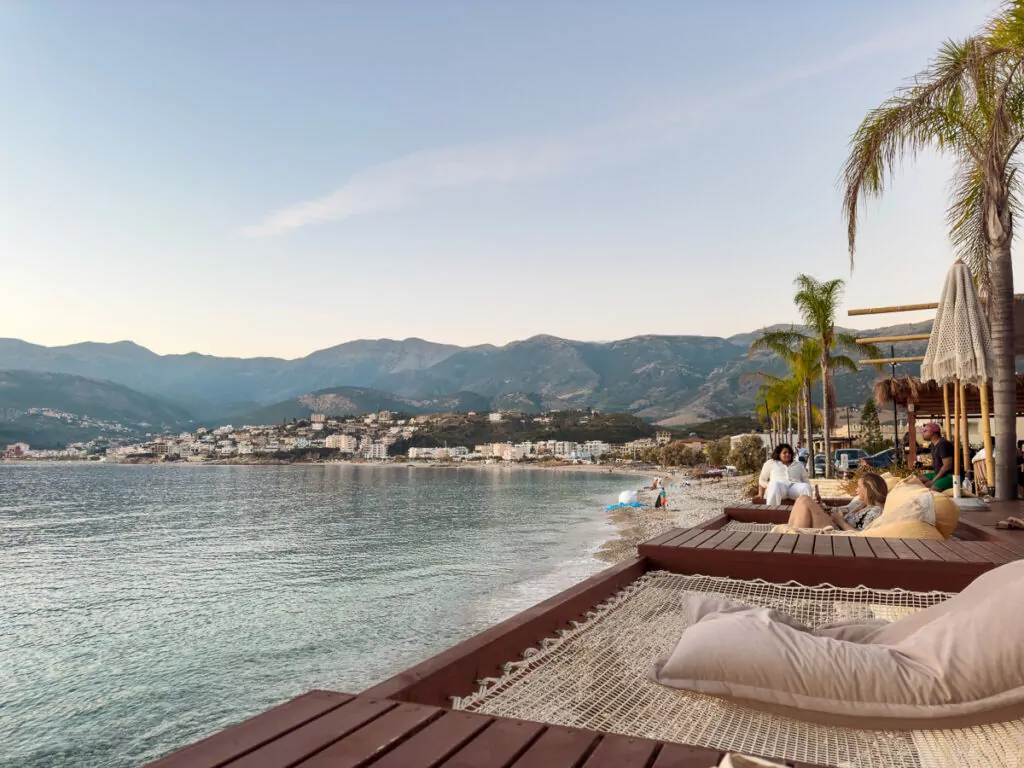
Where to stay in the Albanian Riviera
Budget:
- Sarandë Backpackers in Sarandë (9/10 from 400+ reviews)
- Hostel on the Hill in Himarë (9.8/10 from 11 reviews)
- Vlorë Backpackers Hostel in Vlorë (8.9/10 from 600+ reviews)
Mid-range:
- White Residence Luxury Apartments (my top pick in Sarandë, I extended my stay for another week because it was so great! Spacious, ocean view balcony, full kitchen, bed with duvet, great air con. 9.5/10 from 290+ reviews)
- Hotel Golden in Ksamil (loved my stay here too, spacious room with kitchenette, decent air con, a short walk from the beaches. 8.7/10 from 45+ reviews)
- Vila Soleil in Vlorë (9.6/10 from 100+ reviews)
- Hotel Lindi in Sarandë (9.5/10 from 970+ reviews)
- Da Luz Boutique Hotel in Sarandë (9.6/10 from 280+ reviews)
Luxury:
- Rea Boutique Hotel in Himarë (9.3/10 from 420+ reviews)
- Maritim Marina Bay Resort in Vlorë (8.7/10 from 1100+ reviews)
- La Brisa Boutique Hotel in Dhermi (8.8/10 from 200+ reviews)
- Prado Luxury Hotel in Himarë (8.9/10 from 90+ reviews)

Ohrid, North Macedonia
(If you’re going to the Albanian Riviera and want to continue to the rest of the highlights you’ll need to catch the bus back to Tirana to connect to a bus to Ohrid. If you’ve only got two weeks in the Balkans and are desperate for the riviera then you probably need to either start or finish in Sarandë, otherwise you’re wasting quite a lot of time getting down there and back!)
How to get from Tirana to Ohrid: Direct bus, 2.5h
How long to stay: 2 days

About Ohrid
Nestled on the shore of Lake Ohrid, the town of Ohrid is a treasure trove of history and natural beauty, and it’s another stop on this two week Balkan itinerary that really exceeded my expectations.
From ancient settlements to religious sites to unspoiled scenery, it offers the perfect combo of history, culture and views that will blow your mind.

Things to do in Ohrid
- Take a free walking tour to learn about the significance Ohrid has played in Balkan history
- Buy authentic Ohrid pearls, made from shells using a secret process that’s been passed down for generations
- See the iconic Church of St. John at Kaneo. Move over Santorini blue domes, I reckon this is the most photogenic church in Europe!
- Take it easy with a boat cruise
- Paraglide for epic lake and mountain views
- Visit the Monastery of St Naum and join a rowboat tour on the natural springs, one of the most incredible and underrated natural sights in Europe. There are multiple rowboat operators who will vie for your business, but Nikola at boat #1 is the best! He’s been showing travellers the springs since 1998 and he’s super passionate about his country, and his tour goes further than any of the other boats.
- Visit a monastery winery (yes, that’s a thing) for wine tasting


Where to stay in Ohrid
Budget:
- Sunset Lake Hostel (8.9/10 from 570+ reviews)
- Old Town Hostel Ohrid (9.60/10 from 840+ reviews)
Mid-range:
- Villa Trofej (9.5/10 from 140+ reviews)
- Velestovo View Apartments (9.9/10 from 230+ reviews)
- La Vista Luxury Villa (9.7/10 from 270+ reviews, out of town but sooo cheap)
Luxury:
- Inex Olgica Hotel & Spa (8.1/10 from 580+ reviews)

Skopje, North Macedonia
How to get from Ohrid to Skopje: Direct bus, 3h 10m
How long to stay: 1 day
About Skopje
North Macedonia’s quirky capital is unique to say the least, and the country’s identity crisis is abundantly clear as you walk through its biggest city. Where else would you find London-style red double decker buses, a weird amount of statues (seriously, statue overload), pirate ships and neon signs lighting up the main square?
There’s more to the story behind Skopje’s *ahem* interesting energy: a combination of rotating cultures in charge since ancient times, a devastating earthquake in the 1960, and its location at the crossroads of the Balkans between warring cultures and countries. It wasn’t my favourite Balkan city, but it’s super interesting and the food and nightlife scene makes it worth a visit.

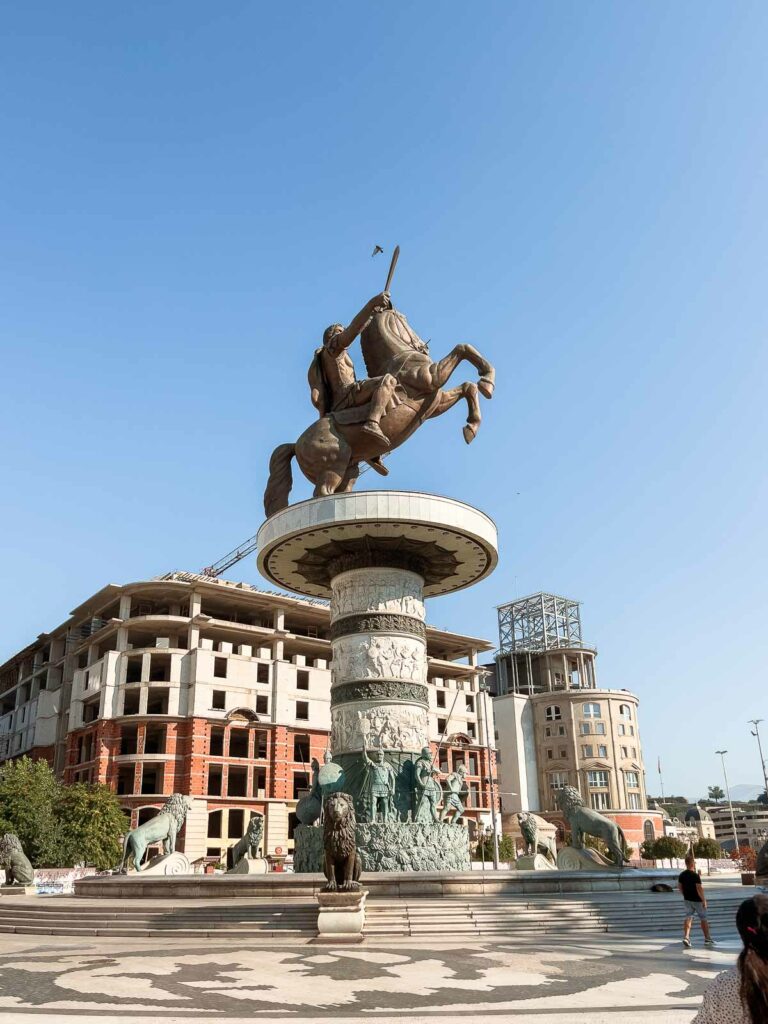
Things to do in Skopje
- See the statues from the controversial Skopje 2014 project, there’s more than 130!
- Wander the historic Ottoman bazaar
- Marvel at the view from the 6th century fortress
- Visit the Mother Teresa Memorial House to learn about the Nobel Peace Prize winner
- Walk through the Museum of the Macedonian Struggle to gain insight into how hard Macedonians have fought for their independence
- Let your hair down with a night out, Skopje’s nightlife is unexpectedly epic
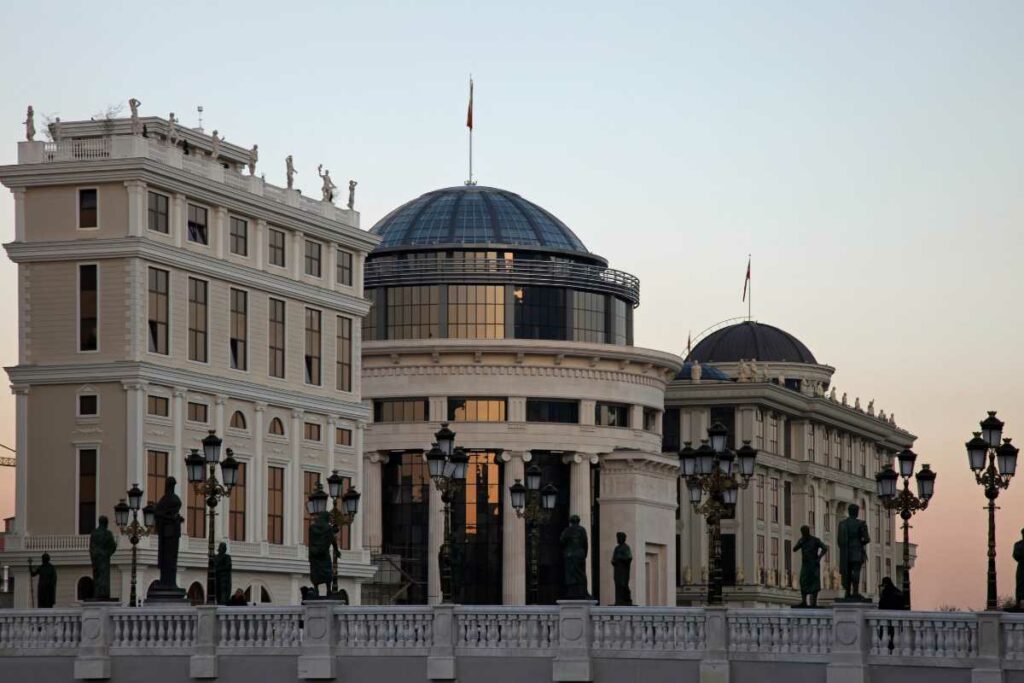
Where to stay in Skopje
Budget:
- Shanti Hostel (9.1/10 from 300+ reviews)
- Alpi Hostel (9.6/10 from 44+ reviews)
- Hi Skopje Hostel (9.2/10 from 190+ reviews)
Mid-range:
- Hotel Senigallia (9.1/10 from 1600+ reviews, it’s the aforementioned pirate ship!)
- Osten Art Hotel (9/10 from 980+ reviews)
- Sienna Apartments (9.9/10 from 30+ reviews)
- Premier Hotel (9/10 from 890+ reviews)
Luxury:
- The Hunter’s Lodge Kamnik (9.5/10 from 130+ reviews)
- Limak Skopje Luxury Hotel (9.1/10 from 2580+ reviews)
- Bushi Resort & Spa (8.3/10 from 1840+ reviews)

Sofia, Bulgaria
How to get from Skopje to Sofia: Direct bus, 5h
How long to stay: 2-3 days
About Sofia
If you’re a bit of a history nerd (I say that with love 🤓) or you count good food as one of your main passions, a Sofia city break is an essential part of your Balkan travel itinerary.
As one of the oldest cities in Europe, you can witness a mind-blowing range of historical chapters with a single 2 hour walking tour, where you’ll pass ancient Roman ruins, Ottoman-era mosques, Soviet government buildings and contemporary street art.
And on the food front there’s more than enough to fill your stomach with 2-3 days in the city, offering everything from street food to traditional Bulgarian cuisine to fine dining at a very affordable price point.

Things to do in Sofia
- Do the top-rated free Sofia walking tour, the best way to get the lay of the land
- Join Balkan Bites for a free food tour to taste some of the city’s iconic flavours
- Marvel at the grand Alexander Nevsky Cathedral, inside and out
- Search for the city’s best and brightest street art
- See the impressive frescoes at Boyana Church
- Take a day trip to Seven Rila Lakes and Rila Monastery
- Eat your way around the city, some of my favourites are Shtasteliveca for world-class home-style cooking, Cosmos for innovative fine dining, Rainbow Factory for brunch, Skapto Burger for fast food, Furna for cheap pastries and bread, Djanam for steak and Bistro Pesto for paninis
👉🏼 Read more Sofia suggestions in my Sofia city break guide >>


Where to stay in Sofia
Budget:
Mid-range:
- Maria Luisa INTROVERT Hotel (my personal favourite, ideal for digital nomads)
- Hotel House K21
- Art ‘Otel
Luxury:
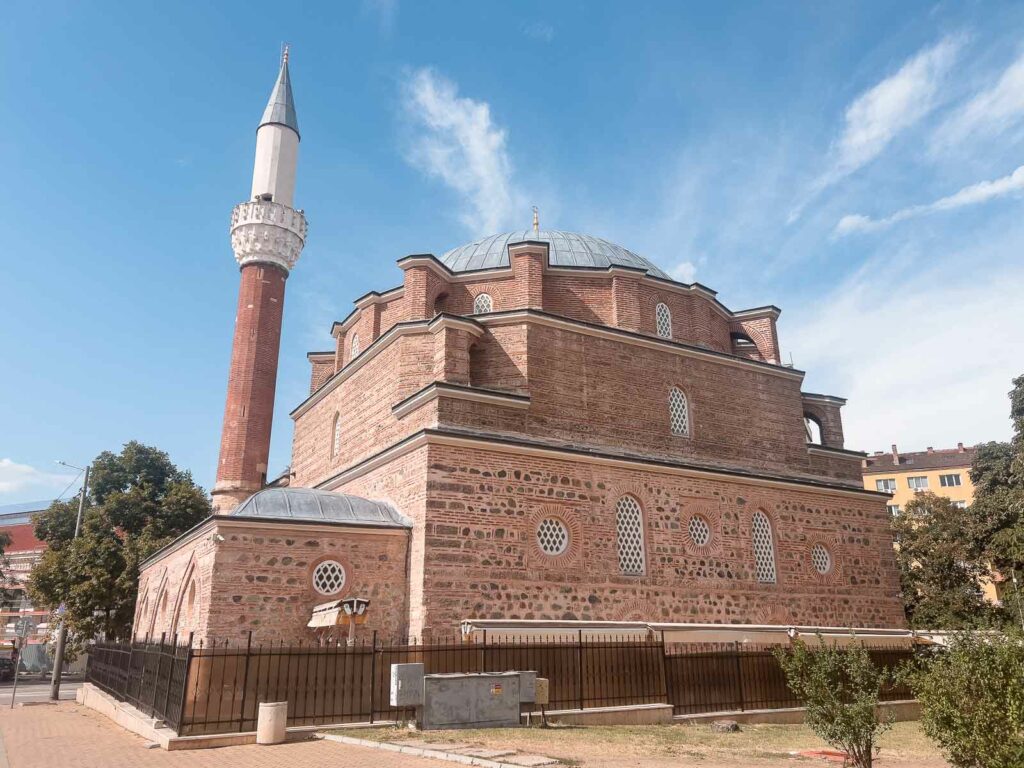
Bucharest, Romania
How to get from Sofia to Bucharest: Direct bus (6-8h) or a train (10h, direct in summer but with one easy change outside of summer)
How long to stay: 2-3 days
About Bucharest
Lovingly known as ‘Paris of the East’, Romania’s capital is where old and new collide.
Grand buildings in the charming Old Town house TikTok-famous bookstores and craft breweries, symbols of resilience are dotted between the Soviet monuments they protest against, and there are museums, churches and even a world-class thermal spa complex to fill your time if you want to add this to your Balkan tour itinerary.

Things to do in Bucharest
- This top-rated Communism walking tour is essential to gain insight into Bucharest’s history
- Or join this Dark History walking tour for a dark tourism experience
- The city is pretty spread out, a bike tour will let you see the main sights without wasting time getting from A to B
- Eat a traditional meal at the famous Caru’ cu Bere restaurant, one of the oldest in Romania (it opened in 1879!)
- Pick up a book at Cărturești Carusel, an eclectic and very photogenic bookshop
- Treat yourself to some self-care with a trip to Therme Bucuresti, a gigantic thermal spa with loads of pools, saunas, steam rooms, waterslides and more (book the Elysium experience for access to the adults only area)
- Head to Amethyst Sky Bar for a drink at sunset
- Day trips from Bucharest (or onward travel) include the Transylvanian castles and the iconic Transfagarasan Highway


Where to stay in Bucharest
Budget:
- Hostel Sport (9.1/10 from 600+ reviews)
- Nest Boutique Hostel (8.4/10 from 250+ reviews)
- T5 Social (9.1/10 from 160+ reviews)
Mid-range:
- Elysium (9.5/10 from 600+ reviews)
- Nobel Boutique (9.5/10 from 490+ reviews)
- Tempus (9.5/10 from 30+ reviews)
- NOVOS ApartHotel (9.7/10 from 50+ reviews)
Luxury:
- HOLT Bucharest, they have a variety of apartments and studios in the Old Town as well as some in more local neighbourhoods, all with stunning interior design
- Radisson Blu (9.5/10 from 700+ reviews)
- Epoque Hotel (9.2/10 from 850+ reviews)
- The Marmorosch Bucharest (9.1/10 from 5000+ reviews, worth a splurge!)
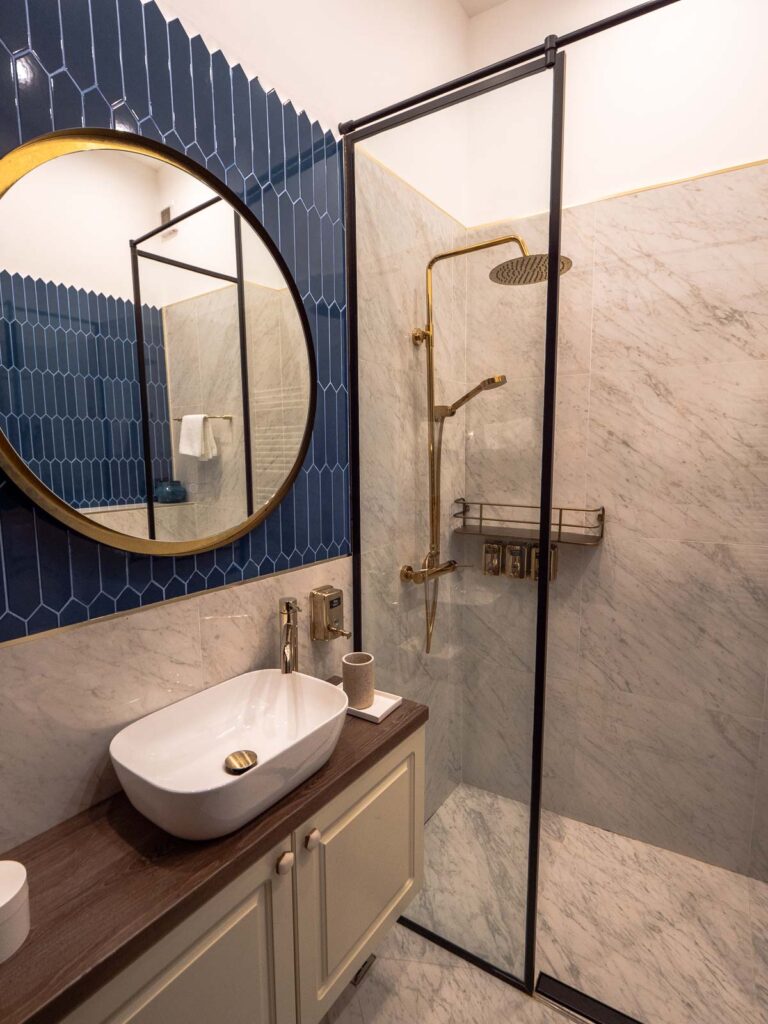

Belgrade, Serbia (difficult to get to!)
How to get to Belgrade: Partly due to infrastructure limitations and partly due to political tensions with its neighbouring countries, Belgrade is difficult to get to from some other places on this itinerary, so if you want to include it on your Balkan travel itinerary you’ll need to figure out where it can sit.
There are no public transport connections between Belgrade and Sarajevo, or between Belgrade and Bucharest, which makes things tricky as that would make this itinerary a nice and satisfying loop!
Instead, your options are:
- Direct bus from Sofia (6h) to connect it with Bulgaria or Romania
- Direct bus from Skopje (6h 15m-8h) and then come back down to Sofia afterwards
- Direct bus from Zagreb (5.5h) if you’re visiting northern Croatia
- Direct bus from Budapest (6h) if you’re coming from/continuing on to Central Europe
- Train from Bar in Montenegro (11h, one of the most beautiful train rides in Europe)
How long to stay: 2 days

About Belgrade
Belgrade is still finding its feet, in the process of moving on from the generational weariness that comes from back-to-back culture wars and a dictatorship that crippled Serbia’s economy and global standing.
It’s not as polished as some other Balkan capitals, but youthful energy, gritty determination, creativity and tolerance are all contributing to Belgrade’s growing popularity as a tourism destination. Crazy cheap food, legendary nightlife and opulent churches await.
Things to do in Belgrade
- I know I sound like a broken record, but do a free walking tour! The history of the Serbian capital is too complex to grasp with a Wikipedia deep dive, it’s best to hear it from a local
- Visit Saint Sava Temple, I’d go as far as saying this is the most magnificent church in the Balkans. Better interiors than Alexander Nevsky in Sofia.
- Experience the splavovi nightlife scene, where you’ll find clubs in boats permanently moored on the river
- Explore Kalemegdan Fortress
- Learn about Yugoslavia and its former President Josip Tito at the Museum of Yugoslavia


Where to stay in Belgrade
Budget:
- Hostel Iris (8.6/10 from 550+ reviews)
- Pop Art (9/10 from 570+ reviews)
- Hostel El Diablo (9.4/10 from 120+ reviews)
Mid-range:
- Iva Old Town (9.5/10 from 200+ reviews)
- Radisson RED (9.8/10, just opened in March 2024)
- H41 Luxury Suites (9.5/10 from 500+ reviews)
Luxury:
- Prezident Palace (9.6/10 from 540+ reviews)
- SAINT TEN (9/10 from 650+ reviews)
- Square Nine (9.2/10 from 300+ reviews)
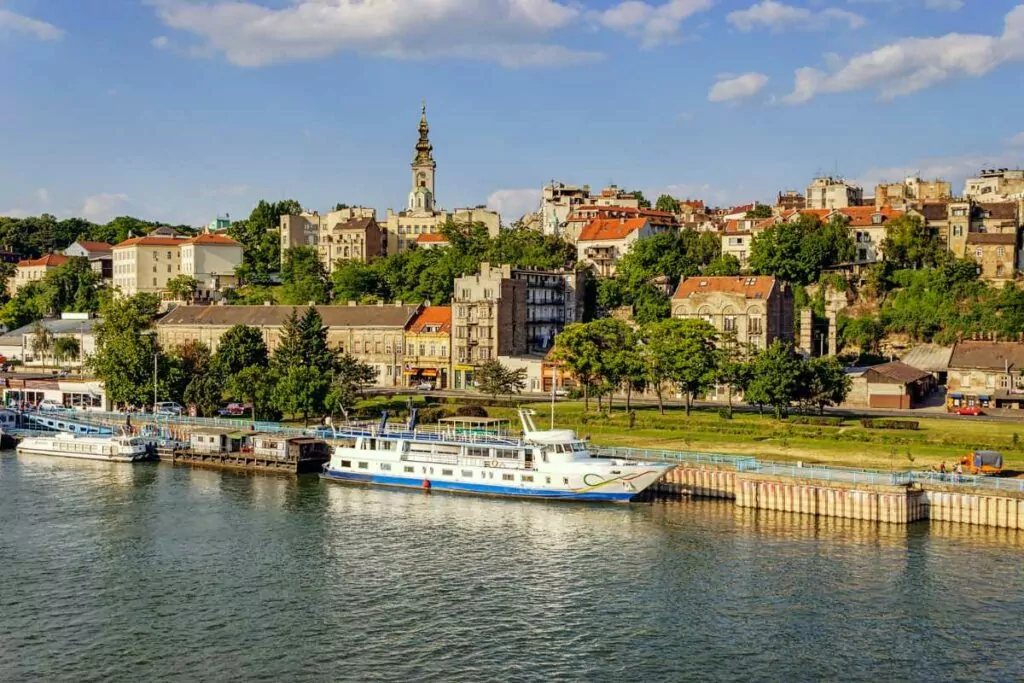
Balkans itinerary add ons and detours
I’ve left a couple of destinations out of this itinerary because they’re too far away or tricky to get to to easily fit into two weeks, but if you’ve got more time or you’re happy to drop a decent chunk of the highlights above, these are some options for you.
See more of Northern Croatia
In the itinerary above I’ve only included Dubrovnik, because it’s the easiest stop between Bosnia & Herzegovina and Montenegro. Croatia is also the most expensive country in the Balkans so dropping other destinations for more time here will hit your budget big time.
If budget isn’t a concern for you and you’re keen to explore more of the Croatian coast you could visit:
- Zagreb for Croatian culture and quirky museums (direct buses from Sarajevo and Belgrade)
- Plitvice Lakes National Park the famous waterfalls (day trip from Zagreb or Zadar)
- Zadar for a much quieter coastal experience than Split or Dubrovnik (direct bus from Zagreb)
- Split for nightlife and seaside vibes (direct bus from Zadar)
- The islands with a Croatia island hopping tour
- And from Split you can catch a direct bus to Dubrovnik to continue through to Montenegro and beyond

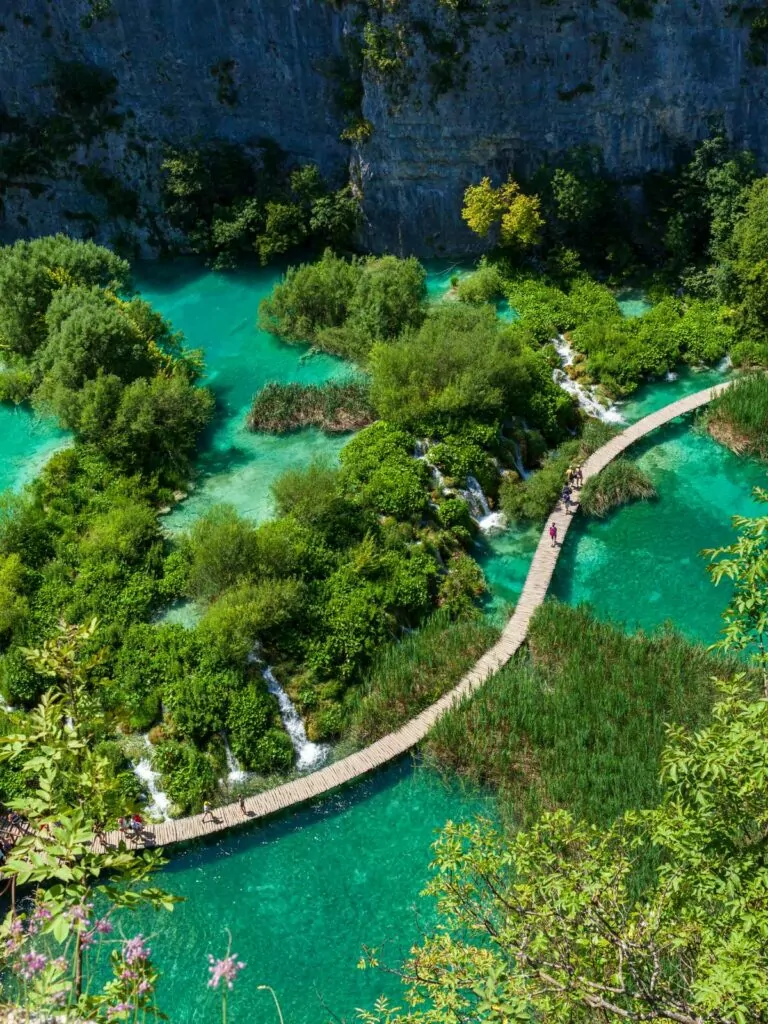
Add on Greece
Greece is geographically part of the Balkan region, but from a travel perspective it’s really too big to try and include it in a two week Balkans itinerary while doing it justice. In saying that, there are a couple of potential add ons if you can compromise on a few of the other stops.
Sporades Islands
You can catch a direct bus from Skopje to Thessaloniki (4h) or Sofia to Thessaloniki (5h), and from there you can use buses or trains to reach the mainland gateways to different islands like Skopelos and Alonissos in the Sporades.
These islands are far less touristy than Santorini, Mykonos and the like, but I think they are just as beautiful.
Skopelos is where a lot Mamma Mia was filmed, with a hilly, whitewashed old town and some of the best beaches I’ve ever been to. It’s more popular than Alonissos because of its filming locations, and July and August can get pretty busy with Jet2 package holidayers, but it’s still a fraction of what the Cyclades would be like.
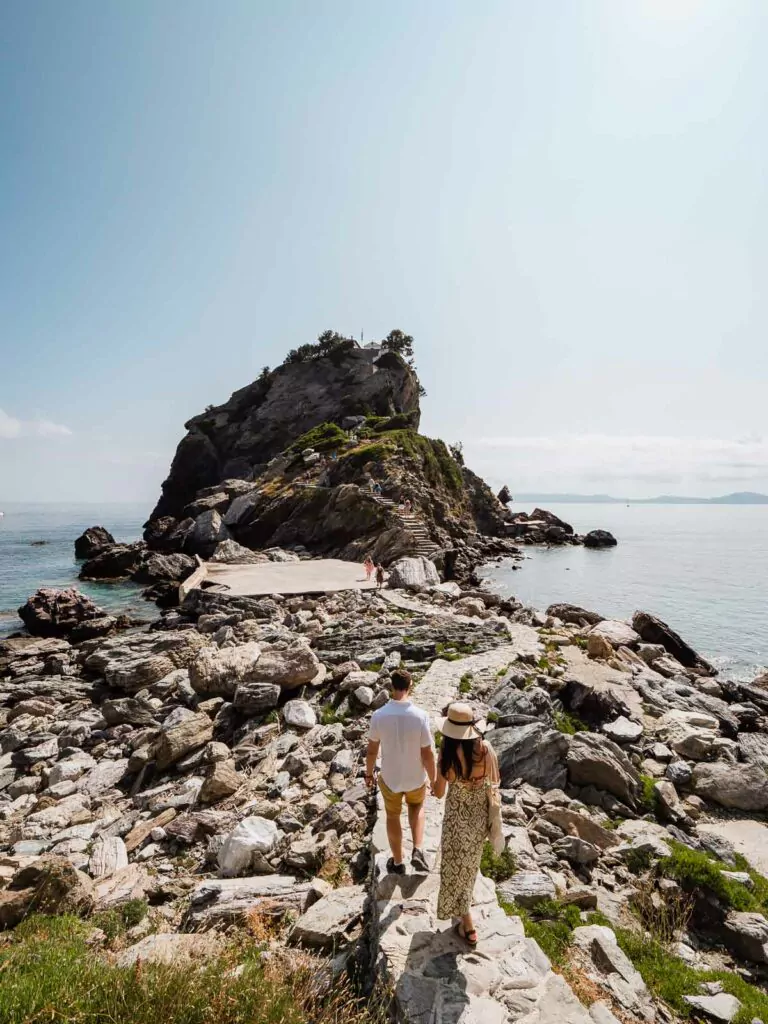
Alonissos is even further off the beaten track, the next stop on the ferry after Skopelos, but you’ll be rewarded for the long journey with unspoilt nature and authentic Greek hospitality. This place is so special, it’s hard to put into words.
The only downside of Alonissos is that public transport is very limited so it is best to rent a car or quad bike to get around, you’ll want to be able to reach the best beaches, coves and hiking trails.

Corfu & the Ionian Islands
If you’re doing the Albanian Riviera, Corfu and the Ionian Islands are easily accessible by a short ferry from Sarandë (30m-2h depending on the ferry you book).
In Corfu you can fall in love with the charming old town, discover hidden bays, or use it as a jumping off point for ocean adventures and island day trips. Tourist spots are connected by bus but a car or quad will give you better flexibility.
If you have time for a proper Greek island adventure, consider booking a Greece sailing tour with MedSailors for a week of island hopping. I’ve done three of their trips now and it’s always a highlight of my European summer!


Athens & beyond
If you’re wanting to tick Santorini off your bucket list, or if you need to get to Athens to fly elsewhere, you can extend this Balkan itinerary to get there car-free. From Corfu, you can book a KTEL bus to Athens which takes 8.5 hours (including the ferry to the mainland), it’s a long day but the buses are comfortable enough. Some magical views too!
Spend a couple of days in Athens to visit ancient ruins, sample keftedes and gyros, and watch a sunset from Mount Lycabettus. Or, if you’re keen for sailing, MedSailors has an island hopping trip that leaves from Athens instead.

ERMASS Apartments is my go-to for a premium stay in Athens, newly opened in 2024 with stylish self-catering suites, extremely helpful staff and maybe the most comfortable bed I’ve ever slept in. This place felt like a home away from home.



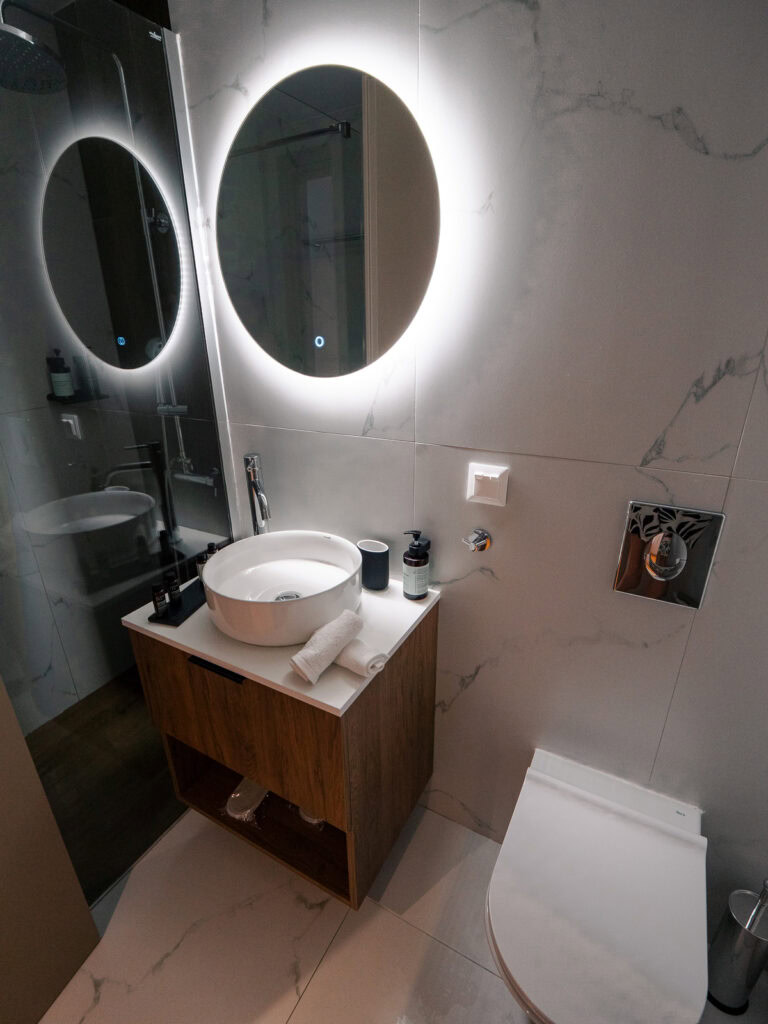
For a cheaper stay, Cabins Sleeping has budget-friendly private rooms with en suites and mini fridges, nothing fancy but fantastic value.
Add on Transylvania, Romania
If you’re keen on seeing Romania’s opulent castles and romantic old towns, Transylvania is a fantastic addition or detour for at least 3-4 days, ideally a week. You can book a group tour like this one to minimise your planning, or you can find bus/train transfers between the main cities and then use local buses, taxis or excursions to get to the castles.
The best places to visit in Transylvania are:
- Brașov
- Sighișoara
- Sibiu
- Bran Castle (Dracula’s castle)
- Hunedoara Castle
- Peleș Castle (on the border of Transylvania)


Add on Kosovo
I didn’t include Kosovo on this itinerary because it’s a bit confusing to figure out the border logistics, and I haven’t been there myself so I don’t want to give you any incorrect info. Below is my understanding of the situation but please do your own research to make sure you know what to do.
The main thing to know here is that Serbia doesn’t recognise Kosovo as a country, they see it as part of their territory, so if you enter Kosovo from North Macedonia and then try to cross the ‘border’ to Serbia, the Serbia border control will view this as you having entered Serbia illegally. Which is a black mark you certainly don’t want against your passport 🙃

You can enter Kosovo from North Macedonia, Albania or Montenegro and then exit via one of these borders no problem, and you can fly in and out of Kosovo too.
You can also enter Kosovo from Serbia, the Kosovo-Serbia ‘border’ isn’t an official border so you won’t get a Kosovo passport stamp. If you do this you’ll need to go back to Serbia via that same ‘border’ and then exit Serbia via the airport or their recognised borders. If you go from Serbia to Kosovo, and then from Kosovo on to another bordering country, you won’t have a Serbia exit stamp which can cause issues if you ever want to go back to Serbia.

Suggested 2 week Balkans itineraries for different interests
Phewwww! If you’re still with me after all that info (or if you just skipped here from the top), here are some suggested itineraries for two weeks in the Balkans for different types of trips.
All-rounder Balkans itinerary
- Sarajevo, Bosnia & Herzegovina (2 days)
- Mostar, Bosnia & Herzegovina (1 day)
- Dubrovnik, Croatia (2-3 days)
- Kotor, Montenegro (1-2 days)
- Tirana, Albania (1-2 days)
- Ohrid, North Macedonia (2 days)
- Skopje, North Macedonia (1 day)
- Sofia, Bulgaria (2-3 days)

Coastal Balkans itinerary
- Split, Croatia (2 days)
- Dubrovnik, Croatia (4 days, day trip to Mostar, B&H)
- Kotor, Montenegro (2 days)
- Tirana, Albania (1 day)
- Albanian Riviera or Corfu, Greece (or split time between both, 5 days)

History buff Balkans itinerary
- Sarajevo, Bosnia & Herzegovina (3 days)
- Dubrovnik, Croatia (3 days)
- Tirana (1 day, just a stopover)
- Ohrid, North Macedonia (2 days)
- Sofia (3 days)
- Bucharest (2 days)

Super budget Balkans itinerary
- Belgrade, Serbia (3 days)
- Sofia, Bulgaria (3 days)
- Skopje, North Macedonia (1 day)
- Kosovo (2 days)
- Ohrid, North Macedonia (3 days)
- Shkoder, Albania (2 days)

Foodie Balkans itinerary
- Sarajevo, Bosnia & Herzegovina (3 days)
- Dubrovnik, Croatia (3 days)
- Tirana, Albania (3 days)
- Skopje, North Macedonia (2 days)
- Sofia, Bulgaria (3 days)


2 week Balkans itinerary FAQs
Are the Balkans safe?
The Balkans are generally safe, locals are friendly, and violent crime rates are low. Like any other European country there is a risk of petty crime like pickpocketing, so take the usual precautions like keeping your valuables in a cross-body bag.
The main risk based on my two weeks in the Balkans would honestly be car accidents! I have spent months and months travelling through Europe in the past ten years and genuinely the only time I’ve EVER been truly concerned for my safety is the split second that our bus driver screamed as he had to take evasive action to avoid a head on collision with a car in Albania 😂 the car pulled out in front of us, our bus swerved enough to avoid smashing the car’s driver but the car scraped right along our bus and we had to wait a couple of hours on the side of the road for (corrupt 👀) policemen to give us the correct paperwork for insurance so we could continue our trip.
Are the Balkans safe for solo female travellers?
I felt completely safe as a solo female traveller everywhere in the Balkans, I wandered through most of these cities by myself and would go our for solo dinners without any problems. Keep in mind that some Balkan countries are quite conservative, particularly Albania, Bosnia & Herzegovina, and Kosovo as predominantly Muslim countries, so dressing modestly will help you blend in.
One thing to be aware of is that the local alcohol, rakija, is very strong so just make sure you drink responsibly if you’re hanging out with people you don’t know. While I wish we solo gals could get as drunk as we felt like without being concerned about our safety, unfortunately that’s not the case, and when we’re in foreign countries away from our friends and family the most important thing is that we can get home safely after a fun night out.
Are the Balkans cheap?
Most of the Balkan countries are soooo cheap! Especially Bosnia & Herzegovina, Serbia, Albania and North Macedonia. Bulgaria and Romania are slightly more expensive but still incredibly good value for money.
The most expensive countries in the Balkans are Montenegro (mainly Kotor and Budva) and Croatia (mainly Split, Dubrovnik and the islands). Budget travellers might find it difficult here as the ‘budget’ level of accomm and food are on par with some of the second tier (in terms of popularity) Western European cities, like Porto, Bordeaux, Milan and Naples.
But two weeks in the Balkans is going to cost you much less than two weeks in Scandinavia or two weeks in Switzerland and Italy, for example!
Are the Balkans in the Schengen Zone?
Croatia joined the Schengen Zone in 2023, and Romania and Bulgaria joined the Schengen Zone on 31 March 2024, so these countries count towards your 90 day Schengen Zone limit.
If you’re concerned about going over 90 days in Europe, your time in Albania, Bosnia & Herzegovina, Montenegro, North Macedonia and Serbia won’t count towards this number.

Are the Balkans in the EU?
Croatia, Romania, Bulgaria and Greece are in the EU, the other Balkan countries are not.
What currency do they use in the Balkans?
Balkan countries use different currencies. Albania, Bosnia & Herzegovina, Bulgaria, North Macedonia, Romania and Serbia have their own currencies, while Croatia, Greece, Kosovo and Montenegro use the Euro.
Are there trains in the Balkans?
There are some trains in the Balkans, but the efficiency of the train network can vary between countries. The bus network is much more developed than trains and is the best way to get between most major cities.
Do you need a visa for the Balkans?
Visa rules will depend on your nationality and passport, but if you’re a citizen of the UK, USA, Canada, Australia or New Zealand and are travelling as a tourist (not for work), you are not required to have a visa for any of the countries in this Balkan travel itinerary. Double check visa requirements before you go though.

How do I end up writing TEN THOUSAND words every time I sit down to write a blog post 🙃
I hope this very detailed Balkan trip itinerary has helped you figure out your travel plans to this wallet-friendly corner of Europe! If you have any specific questions you need help with then please let me know in the comments and I will get back to you as soon as I can.
MORE EUROPE NO-FLY ITINERARIES:
- The perfect two month Europe itinerary
- The perfect three month Europe itinerary (with options to tailor it to suit you!
- The perfect Europe Christmas market itinerary
- 5 day Switzerland itinerary
- 10 day Switzerland itinerary
- 3 week Scandinavia itinerary
- Northern Italy & Switzerland itinerary
- 4 day Norway itinerary
- 2 week Poland itinerary
MORE BALKAN TRAVEL INSPIRATION:
- The ultimate two week Albania itinerary
- A tour review of the Travel Talk Amazing Balkans tour
- The perfect city break in Sofia, Bulgaria
- The perfect city break in Bucharest, Romania
- A guide to sailing in Croatia
- Medsailors Croatia sailing tour review
- A travel guide to Skopelos, Greece
- A travel guide to Alonissos, Greece
- Why a Greece sailing tour needs to be on your bucket list
- Planning a trip to Greece: All you need to know
MORE EUROPE TRAVEL INSPIRATION:
- The most beautiful train rides in Europe
- 27 Europe holiday ideas to inspire you
- How to use a Eurail Pass
- Is a Eurail Pass worth it?
- The ultimate Italy bucket list
MY GO-TO TRAVEL PLANNING RESOURCES
Flights ✈️ I use Skyscanner to find the best flights for my trip and then I’ll always book direct with the airline to protect myself from having to deal with dodgy third parties if anything goes wrong.
Trains 🚂 If I’m travelling through Europe, I try to travel by train wherever possible! For an extended trip (2+ weeks) I’ll calculate if a Eurail Pass is worth it, or I’ll book point-to-point tickets through RailEurope or the local train operator.
Accommodation 🛎️ I book almost all of my accommodation through booking.com, they have a user-friendly website + app and many of their options are free cancellation, easily cancelled with a simple click of a button.
Activities 🗽I use GetYourGuide, Klook and Viator to look for activities in the places I visit, or I just Google ‘things to do in [city]’! P.S. If you book anything on Klook you can use the promocode FINDINGALEXXKLOOK to get 10% off
Travel cards 💳 I’m a Wise gal through and through, they’ve been my chosen travel card for more than five years now. You can easily top up your card from your bank account or through Apple Pay, convert your money to local currency, and spend money with minimal fees and the best exchange rates around.
Travel insurance 🩺 I use Cover-More NZ travel insurance for my own trips, I have a comprehensive policy and I’ve only had good experiences with them. Cover-More also has an Australian company, but if you’re from elsewhere then two popular insurance options for global travellers are SafetyWing (cheaper policy, lower coverage) and World Nomads (more expensive but significantly better coverage).
Luggage 💼 I travel with Samsonite Cosmolite suitcases, one 75cm check in bag and a 55cm carry on bag, and I absolutely adore them and will never travel with anything else! They are SUPER lightweight (2.8kg and 1.9kg respectively) so I have much more space for my actual stuff.
Camera gear 📸 I use a iPhone 15 Pro Max for phone photos/videos, and my camera kit includes a Lumix S9 (incredible lightweight full-frame camera, a game changer for travel creators!) with a 20-60mm lens, a Lumix G9 with an 8-18mm and 12-60mm lens, a DJI Mini 3 Pro drone and a GoPro Hero 10. I do all my writing and editing on my ASUS Zenbook 14, it’s lightweight but powerful enough for photo editing and intense blogging sessions.



Super helpful and detailed post! Thank you!
Thanks for the feedback Brianna 🙂 have a great trip!
This is great. I am heading solo to Zadar next week and I plan to do the coast of Croatia and then head inland to Bosnia and Herzegovina. I have planned the first week of my journey in Croatia but I am leaving Bosnia and just going to go with the flow. I hope that works)))). Thank you for this post. It has been extremely helpful. I only wish I had more time.
Bosnia is pretty chill for going with the flow, not too touristy yet so you don’t need to worry too much about planning ahead! Hope you have an amazing time, such a beautiful part of the world 🙂
I enjoyed reading your blog, thank you for all the info! I love Bulgaria and looking forward to visiting other balkan countries. The info you provided will be very useful.